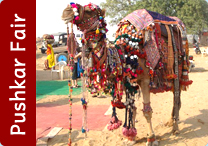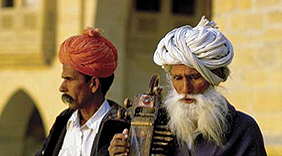
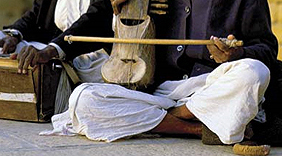

Custom Made Tour
Feel free to let us know if you are looking for customize tour program as all the tour itinerary is sample it can be modify according to your requirements.
Home - History of Rajasthan
History of Rajasthan
Rajasthan
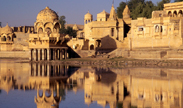
Rajasthan where the mood and rhythm is so overpowering that is impresses even the most seasoned traveler. It has rightly been called a huge open air museum where the relics of a golden past have carefully preserved for the benefit of the tourist. It has something for almost every kind of traveler - for those looking for an active, action-packed holiday there are several places which allow one to enjoy the great outdoors, there is trekking, there are horse and camel safaris through desert sands or along the Aravallies - the oldest mountain range in India. take a royal tour and live like a Maharaja or spend a peaceful and quiet holiday in one of the several off-beat destinations in historic towns, wildlife lovers can spot tigers and other rare species in various wildlife sanctuaries. It is well connected with other parts of the country and can be easily approached from Delhi and Bombay. Fast trains, direct bus and air connection make travel easy and comfortable. Rajasthan is a land where the past still lives on and it is a glorious past, too. It is for this great land that Col. James to add, the writer of "The Annals and Antiquities of Rajasthan" has written, "Rajasthan exhibits the sole example in the history of mankind of a people with standing every outrage barbarity can inflict or human nature sustain, ad bent to the earth, yet rising buoyant from the pressure ad making calamity a whetstone to courage." The annals of Rajasthan present golden examples of countless deeds of velour and selfless sacrifice. A visit to this wonderland will leave a lasting spell on your mind.
Rajasthan has a total area of 343,000 sq km and the most striking feature of this land is its division by the majestic Aravalli range which runs from north-east to south-west for about 688 km. It is the backbone of the state ad divides it into two regions which totally different geographical features.
North West of the Aravallis are the Jodhpur, Jaisalmer, Barmer and Bikaner regions, it is the home of arid plains and the shifting sand dunes of the great Thar desert. Covering a total area of 196,150 sq km, the hard compact earth here is covered by shifting sand dunes and sparsely dotted with scrub and thorny babool. Water levels are very low and have been for so many centuries. The Italian traveler Manucci, one of the several visitors who came to this area and put their impression on record, came over to this region in the 17th century and noted :
"Wells are so deep that when water is drawn out of them with the help of oxen, those who set these animals to work beat a drum as a warning" that the pot is the mouth of the well and they are about to draw water."
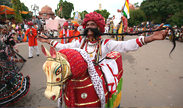
The harsh dry climate has, however, forced the people to evolve a semi-nomadic lifestyle; when survival becomes difficult these people move out with their cattle to more welcoming pastures, some use their skills as folk performers to earn a livelihood. The wanderers leave their homes but carry the desert and its history in their hearts and follow each custom scrupulously. They may move far away from their land but never move away from their culture. When the desert is a little more welcoming it becomes a rearing ground for camels, cows and buffaloes. Lack of vegetation has been compensated for by the health of minerals that are to be found in several parts of this fascinating region. The other side of the hills is a land rich is vegetation. Aravalli, or, a beam lying across, has a greater presence here. Hard granite rocks, scattered hillocks, areas rich in silver, zinc and lead deposits.. There are also long stretches of dense forest lush green valley are fertile fields. This area is drained by several rivers - the most important being the mighty Chambal river which hurtles through the rocky terrain of the Hadoti region.
Geologically, many areas in Rajasthan are older than the Himalayas therefore it was only natural that civilization came to Rajasthan much before it came to the rest of India. Excavations at Kalibangan, in Ganganagar district, prove that a fully developed and organized society was in existence in that area much before the Harappan culture. Numerous other prehistoric and proto-historic sites exits in Rajasthan.
The later history of Rajasthan is a history of various kingdoms and their regular wars with one another. It wasn't until the mid-sixth century that the brave Rajputs, warriors par excellence, came to dominate the region and wrote the most glorious chapters of history with their blood and blade. Rajasthan was divided into kingdoms and the valiant Rajputs kept themselves busy with skirmishes amongst the neighboring kingdoms or else they faced the Turks, the mighty Sultans of Delhi lasted Sultanate and later the Great Mughals.
The conflict between the Rajputs and the Muslims Rulers of Delhi lasted for almost 550 years. This period saw the rise of Prithvi Raj Chauhan Maharani Padmini, the beautiful queen of Rana Rattan Singh of Chittaur, Rana Sangha, Man Singh of Ajmer and Rana Pratap of Chittaur, and scores of other names which became hallowed in folk memory. It was a period of fierce loyalties and of death before dishonour. It is this period in the history of Rajasthan that continues to live on in the proud inhabitants of this region and gives it a special charm of its own, unmatched by any other place, anywhere in the world.
Rajasthan Facts
Area : 342,239 Sq.KmCapital : Jaipur
Languages : Hindi and Rajasthani
Districts : 32
Population : 56,473,122
Males : 29,381,657
Females : 27,091,465
Literacy : 61.03%
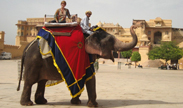
Cliffs form the backdrop of Jodhpur, disappear into the endless barren plain from which the medieval fort of Nagaur rises as a landmark. Beyond this is the Thar desert which is a part of the great Indian desert-Burning like a furnace even in early March, it is the 'Maru-kantar', the region of death. Aravalli range starts from the borders of Delhi and becomes well defined before Alwar. The forests of Alwar, Bharatpur and Sawai- Madhopur are the home of the tiger, the panther, the wild boar, the blue bull and the more graceful and agile animals of the deer family.
The plains here are level and flat, with rich alluvial loam. Down south, in Kota and Bundi, in the Chittorgarh and Bhilwara districts, wheat, maize, paddy and sugarcane fields sprawl along the river-banks.
The very opposite of its western counterpart, Eastern Rajasthan has much that belies the notion of Rajasthan being a desert state. The plateau on which this picturesque city stands marks the highest elevation of the plains of North India and it is called the watershed of India. Guru Sikhar or the Hermit's peak which is the highest point of the range near Mount Abu may be described as the roof of this region.


